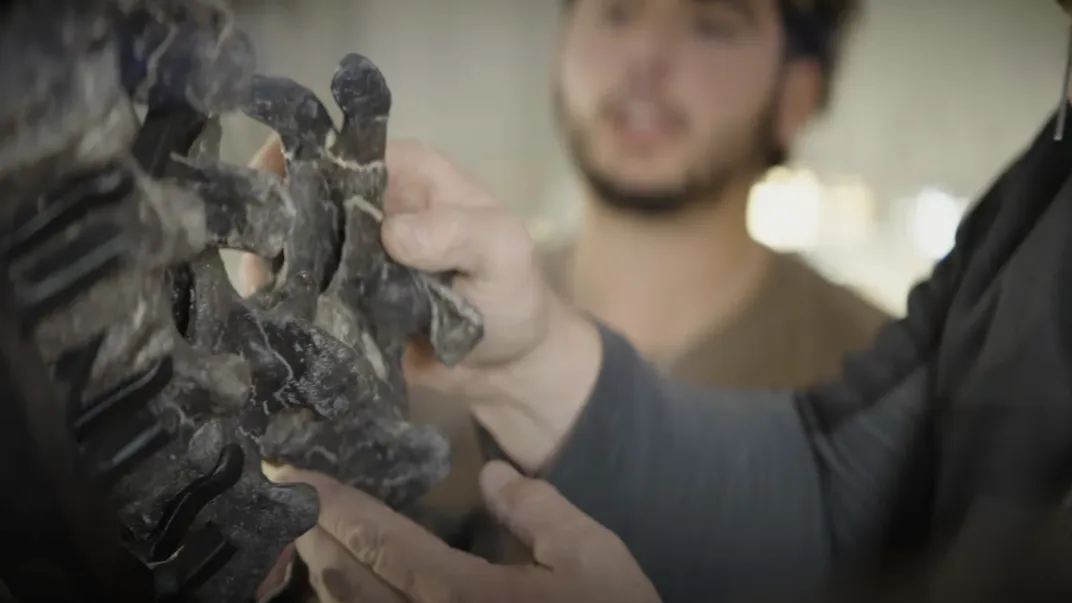Enormous Stegosaurus Skeleton Called ‘Apex’ Smashes Auction Records and Sells for $44.6 Million
The 150-million-year-old dinosaur became the most expensive fossil ever sold at auction, raising old questions about whether such specimens should be put up for sale
:focal(4141x3115:4142x3116)/https://tf-cmsv2-smithsonianmag-media.s3.amazonaws.com/filer_public/f9/53/f95302c9-5ef8-40c8-8841-09f6795634e9/apex_photo_credit__matthew_sherman_3.jpg)
“Apex” was already extraordinary. Billed as the largest, most complete Stegosaurus fossil ever recovered, it stood out even before it went up for sale. Wednesday, it was auctioned at Sotheby’s annual Geek Week series—where it sold for a record-breaking $44.6 million.
Named for its prominent size—11 feet tall and 20 feet long—the skeleton was predicted to fetch up to $6 million. Instead, it smashed every expectation and became the most expensive fossil ever auctioned off.
Hedge fund billionaire Kenneth Griffin made the historic bid, according to the Wall Street Journal’s Kelly Crow. Sotheby’s, however, has yet to announce the buyer. Griffin, the founder and CEO of Citadel, has donated millions to Chicago’s Field Museum to fund dinosaur exhibits.
The purchase came after a dramatic 15-minute session in which seven bidders from around the world placed ever-higher offers on the fossil over the phone.
The roughly 150-million-year-old dinosaur is believed to have lived to an advanced age and has no signs of combat or predation-related injuries, per the Sotheby’s auction listing.
“If you combine size, completeness and bone preservation, it is the best Stegosaurus I’ve seen,” Rod Scheetz, a curator at the Brigham Young University Museum of Paleontology, told the New York Times’ Asher Elbein in May.
Stegosaurus was a slow-moving, herbivorous dinosaur that lived during the Late Jurassic period, between 145 million and 152 million years ago. Its fossils have been found in North America, Europe, Asia and Africa. The dinosaur had defensive spikes on its tail and distinct bony plates along its back, which may have been used for species recognition or regulating body temperature. Stegosaurus could weigh almost 14,000 pounds and usually grew to a height of 9 to 13 feet and a length of 21 to 30 feet.
“Apex” is more than 30 percent larger than “Sophie,” the previously most intact Stegosaurus specimen, which is now in the collections of the National History Museum in London.
“Through the careful process of excavation, preparation and installation, ‘Apex’ sets a new standard for all future discoveries of this magnitude and further reinforces the enduring appeal of Stegosaurus and its vaunted status in popular culture,” Cassandra Hatton, Sotheby’s global head of science and popular culture, says in the listing.
Dinosaur fossils are often met with excitement at auctions—and they garner high prices. In 1997, “Sue” the T. rex sold to the Chicago Field Museum for $8.36 million. In 2020, “Stan,” another T. rex, sold to an anonymous buyer for $31.8 million, and it’s now housed at a natural history museum in Abu Dhabi, United Arab Emirates. In 2022, “Hector,” a bipedal Deinonychus, sold to an undisclosed buyer for $12.4 million.
But to many scientists, these sales represent a troubling trend. In recent decades, researchers have watched monumental fossils be purchased by private collectors rather than ending up with research institutions, per the New York Times. This can restrict educational opportunities and limit the scientific discoveries that might ensue with further examination.
“I know how strapped for cash, in general, museums are. … Five or six million dollars is the sort of money that almost no museum in the world can afford to pay,” Diego C. García-Bellido, a senior researcher of paleontology at the South Australian Museum, told the Washington Post’s Kelly Kasulis Cho and Jonathan Edwards in May.
García-Bellido added that Sotheby’s classification of “Apex” as an unspecified species of Stegosaurus could suggest either that its species is intentionally being kept secret or that scientists haven’t had the opportunity to properly examine it.
In a statement Wednesday, Sotheby’s said the buyer “intends to explore loaning the specimen to a U.S. institution,” per CNN’s Catherine Nicholls.
Jason Cooper, a commercial paleontologist, discovered the specimen in May 2022 in the Morrison Formation on his private land in northwest Colorado; excavation was completed in October 2023. The paleontologist has unearthed various fossils previously, some of which are now located in institutions around the country.
In addition to the skeleton, the “Apex” buyer will receive a copy of the dinosaur’s scan data and a full license to use its 3D data. The listing explains this “will allow primary information about the dinosaur to remain with the specimen and promote collaboration in future research and education.”
“If what the auction house is saying is true, and what I’m seeing in these photos is genuine, then this skeleton really does belong in a museum, where it can be conserved, studied by scientists, and put on display to inspire people from all walks of life,” Steve Brusatte, a paleontologist at Scotland’s University of Edinburgh, told CNN’s Lianne Kolirin in May.

